The Adirondack Park is undergoing the greatest expansion of motorized recreational uses in the history of the “forever wild” Forest Preserve. With each new Unit Management Plan (UMP) or amendment, motorized uses are expanded primarily through creation of a major new snowmobile trail network. These large road-like “trails”, called class II community connector snowmobile plans, are unlike any other type of trail on the Forest Preserve. These trails are designed and built for high speed motorized uses.
The Department of Environmental Conservation (DEC) and Adirondack Park Agency (APA) are currently working to amend three UMPs in the central Adirondacks and approve a new one for the Essex Chain Lakes area. Unfortunately, state agencies are are planning to widely violate state laws, regulations and policies to build this new trail system.
The planning by the DEC and APA to link communities in the central Adirondacks through class II community connector snowmobile trails has failed to fully consider and evaluate a number of factors. The omitted information is important because it has a direct impact on compliance with state laws and long-term natural resource protection for the Forest Preserve. Protect the Adirondacks has urged the APA to include this information in its evaluation of various DEC proposals.
PROTECT prepared the map below to assist APA staff and Commissioners in review of the impacts of this major expansion of snowmobile trails.
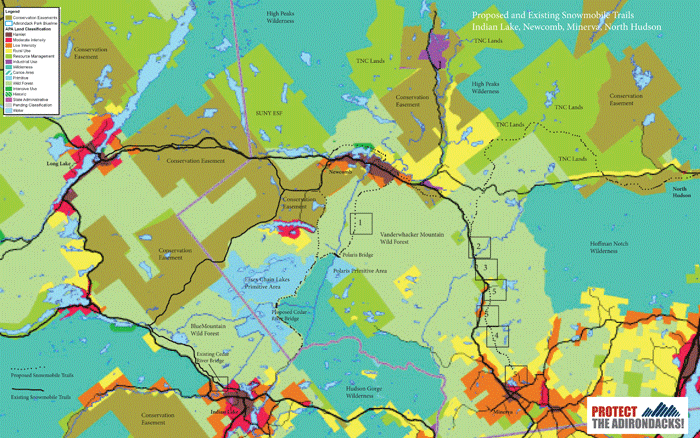
Map of part of the overall new snowmobile trail system that the Department of Environmental Conservation and the Cuomo Administration are looking to build.
Click here for a large format map in PDF.
There is Already One Snowmobile Bridge over the Cedar River
The DEC and APA have discussed the creation of a new Class II Community Connector snowmobile trail from Indian Lake to Newcomb that will utilize the recently created Wild Forest Corridor between the Hudson Gorge Wilderness and the Essex Chain Lakes Primitive areas. A trail along this corridor would cross the Cedar River and run along the Chain Lakes Road to Indian Lake. This trail requires construction of a new bridge over the Cedar River.
One factor frequently omitted in APA-DEC public planning is that there is already a snowmobile bridge over the Cedar River six miles upriver, located 1.5 miles east of Route 30, in the Blue Mountain Wild Forest Area (see map above). This is a major bridge over a major river. The existence of this bridge is never mentioned in the public planning and review regarding the possibility of building a second bridge over the Cedar River to access the Chain Lakes Road.
The “Snowmobile Trail Guidance” recognizes the major financial investment to build and maintain snowmobile trails in the Forest Preserve as well as the negative ecological impacts of these major trail systems on natural resources. In light of these considerations, the “Guidance” states clearly that trail replication and redundancy is prohibited. What is more redundant than two snowmobile bridges six miles apart over the same river?
Indian Lake and Newcomb are Already Connected with a Snowmobile Trail
Another factor frequently lost in the APA-DEC public review and discussion of snowmobile trails in the central Adirondacks is that there is already an existing snowmobile trail that connects Indian Lake to Newcomb (see map above). This trail utilizes the bridge over the Cedar River and passes through the Blue Mountain Wild Forest area and state Conservation Easement lands. This trail has long been operational.
Complaints have been made that the section of this trail within the Blue Mountain Wild Forest area is only a class I snowmobile trail, hence it does not allow for higher rates of speed or grooming with larger motor vehicles. Before the APA-DEC move the build a new Class II Community Connector snowmobile trail, along with a second bridge over the Cedar River, an investigation should be made into upgrading the existing trail from class I to class II.
PROTECT is puzzled by the need for a second major snowmobile trail to connect Newcomb and Indian Lake as well as by the failure of the APA-DEC to consider improvements to the existing trail in this age of tight Forest Preserve stewardship resources.
Last, the 2006 NYS Snowmobile plan clearly states that preference for snowmobile trails should be on private lands and conservation easement lands and that the Forest Preserve should be the last consideration. It appears that APA-DEC planning has started with the Forest Preserve and not with other options.
2006 NYS Snowmobile Plan does not List Minerva-to-Indian Lake as a Priority Route
The APA is considering an amendment to the Vanderwhacker Mountain Wild Forest area for a new Class II Community Connector snowmobile trail that roughly parallels Route 28N. At present, the DEC has withdrawn its proposal to build a new Class II Community Connector snowmobile trail through a trailless part of the Vanderwhacker Mountain Wild Forest area east of the Hudson River that would connect to the Polaris bridge. It should be noted that one objective for a new snowmobile trail that utilized the Polaris bridge is to connect Indian Lake and Minerva.
2006 Snowmobile Plan for the Adirondack Park contains a list or priority trail systems to link communities throughout the Adirondack Park. This plan is the definitive policy to date of vital community connection. Under “Community Connection Goals” in the “Trail Section” part of the Snowmobile Plan (pages 45-46), there is no mention of a Minerva-to-Indian Lake snowmobile trail. This was not a major goal for New York and was not recognized as a high priority. The Environmental Impact Study associated with the Snowmobile Plan did not evaluate the impacts of a Minerva-to-Indian Lake trail. PROTECT believes that in order for the APA-DEC to approve and build a Minerva-to-Indian Lake trail, the State must revise the 2006 Snowmobile Plan for the Adirondack Park.
It’s important for the APA-DEC to consider the 2006 Snowmobile Plan for the Adirondack Park when planning for snowmobile trails in the central Adirondacks. It appears that a Minerva-to-Indian Lake class II community connector trail would violate the Snowmobile Plan. The 2006 Snowmobile Plan for the Adirondack Park should be made available to the APA Commissioners.
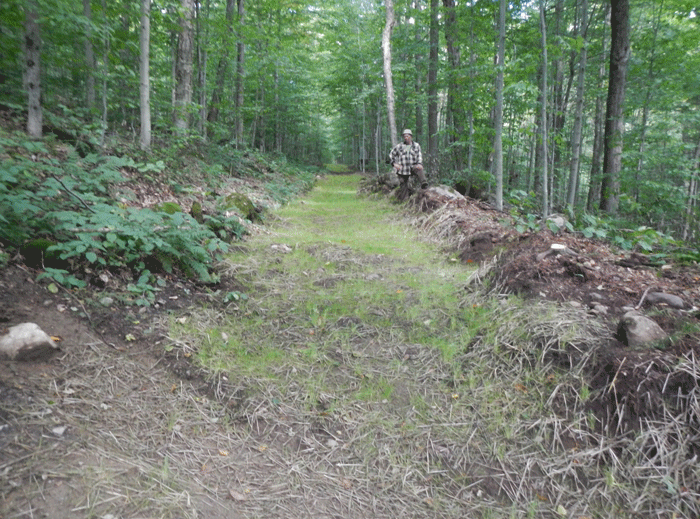
A section of the Gilmantown Class II Community Connector Snowmobile Trail in the Jessup River Wild Forest area where the forest was turned into a grass lawn. This type of land alteration does not happen with other types of recreational trails on the Forest Preserve.
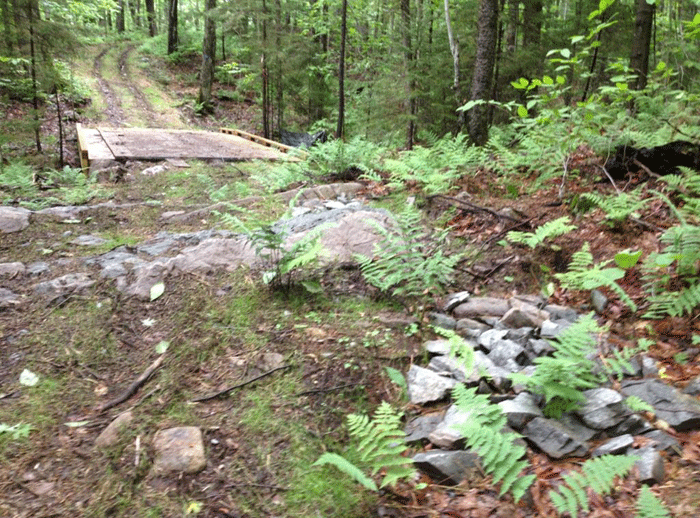
Bedrock is chipped away during trail construction of the Gilmantown Class II Community Connector Snowmobile Trail in the Jessup River Wild Forest area. This type of land alteration does not happen with other types of recreational trails on the Forest Preserve.
Significant Legal and Natural Obstacles Confront Minerva-to-Newcomb Snowmobile Trail
Many major problems confront planners for the Minerva-to-Newcomb snowmobile trail. The Vanderwhacker Mountain Wild Forest UMP approved in 2005 lists eight alternatives for a Minerva-to-Newcomb class II community connector snowmobile trail. It goes without saying that if there was one good option, then eight alternatives would not have been identified. The intervening years have done nothing to remove the significant obstacles facing the APA-DEC regarding approval and construction of a viable Minerva-to-Newcomb snowmobile trail.
Given the significance of six critical barriers to development of this trail, PROTECT urges the APA-DEC not to undertake any trail construction until 100% of a viable trail system is affirmed and publicly disclosed. Following details the barriers that APA-DEC should recognize during its review of a Minerva-to-Newcomb trail.
Significant Legal Questions Must be Answered Regarding Construction of a New Snowmobile Bridge over the Boreas River: In apparent violation of the Wild, Scenic and Recreational Rivers Act and DEC’s Rivers Act regulations, the DEC is trying to build a bridge over the Boreas River, a designated Scenic River. Motor vehicle use is not allowed in a Scenic River corridor. DEC and APA ares cooking up various inventive interpretations for how they can subvert the law.
Practical Barriers for Crossing the Boreas River: A specific location and bridge design has not been provided for where and how the DEC plans to cross the Boreas River. Clearly, the Boreas River must be crossed at some point somewhere to connect Minerva to Newcomb, yet this information has not been made available. PROTECT’s reconnaissance of Forest Preserve lands along the Boreas River north of Route 28N found significant challenges for building a bridge. APA-DEC should be clear-eyed about the practical realities of building this bridge.
Hazards of Roadside Trail on Route 28N: Long stretches of the proposed snowmobile trail are slated to be located on the roadside of Route 28N. This road is already short on good sight lines. PROTECT is concerned about public safety, but we’re also aware than many private landowners are not interested in having a snowmobile trail cross their lands.
These dangers cannot be understated. PROTECT expects to see an answer to this question in the APA’s Response document for these UMP Amendments.
Many Private Landowners Opposed to Snowmobile Trail: There are many private landowners impacted by the proposed Minerva-to-Newcomb trail that PROTECT has heard do not support a snowmobile trail through their land. It’s important that the DEC have 100% of the trail organized with trail agreements before the APA approves this trail or construction of any portion begins.
At the south end of Forest Preserve lands in Minerva, the trail dead-ends 2-3 miles from Sporty Bar, the intended destination. Many landowners between the Forest Preserve and Sportys Bar oppose a snowmobile trail through their lands. It is unacceptable public policy for the APA-DEC to approve and build a trail that is blocked by unwilling private landowners whose wishes must be respected. It is unacceptable for APA-DEC to simply say that the Town of Minerva or the local snowmobile club will work out the details. DEC must connect this trail at the Minerva end to some kind of legitimate trailhead with parking. If this cannot be accomplished, then the trail should not be approved.
There are many barriers along this route from private landowners who want no part of a snowmobile trail through their lands. PROTECT expects to see an answer to this question in the APA’s Response document for these UMP Amendments.
Beautiful, Mature Forests to be Damaged by New Snowmobile Trail: DEC-APA need to provide better information on the condition of the forests that will be impacted by the proposed new Minerva-to-Newcomb trail on the east side of Route 28N in the Vanderwhacker Mountain Wild Forest area. PROTECT’s visits to these areas have found mature forests with many old growth characteristics. PROTECT expects to see an answer to this question in the APA’s Response document for these UMP Amendments.
Newcomb-to-North Hudson Snowmobile Trail
The only major obstacle appears to be barriers from private landowners just west of the Adirondack Northway who oppose this trail passing through their lands. Once again, it’s important that 100% of this trail be organized before any work begins to build it. Also, PROTECT requests that the APA revisit any approvals for a snowmobile trail on private lands once these lands become public Forest Preserve.
These private lands should be respected. Here is one individual who left the Town of Inlet to escape the noise, pollution and degraded quality of life caused by heavy snowmobile use and sought refuge in quiet North Hudson:
I am an Adirondack native having grown up in Inlet N.Y.
We moved to North Hudson 16 years ago and have restored an early 1800’s farm house on 55 acres.
Our land is on both sides of the Blueridge road and has over 800 feet on the Branch River, which is a “studied” river and protected from development by the state of New York. Having seen first hand what happens to a town with heavy snowmobile traffic and what comes with it, we are adamantly opposed to the snowmobile connector going through our or any area of North Hudson N.Y.
North Hudson has no services other than a gas station in the winter and snowmobiling would have absolutely no benefit to our community financially or otherwise. In fact it would be a hardship due to the inevitable strain on our small Emergency Service and Fire Department. As any one knows in the North Country, if you own property and want to build on land that is Wetlands or borders Wilderness or Forever Wild state lands, it is extremely difficult if not impossible to receive an APA permit to do so.
Allowing the snowmobile connector going through our “protected” areas would continue to create divisiveness for Natives and the public at large, showing that the rule of law can change randomly at the whim of a very few.
The mere fact that the only destinations between North Hudson and Newcomb are a gas station and a Bar speaks of how ludicrous this plan is. For many of us, we live here to enjoy the serenity this area has to offer. That’s why we chose to be here and not Lake George or Inlet.
Our town North Hudson needs help from the state to survive, but this is NOT the way. It will not benefit us in any way. We strongly urge you to not allow this connector plan to go through and destroy our wilderness and our way of life.
These UMP Amendments are part of the Largest Expansion of Motor Vehicle Use in the History of the Adirondack Forest Preserve
Construction of Class II Community Connector trail requires extensive construction and terrain modifications to facilitate large bulldozer size groomers and high speed snowmobiling. These trails require extensive use of heavy machinery to excavate, widen, grade and cut bench cuts into trails. These machines remove all understory, require extensive tree cutting of trees over 3″ diameter at breast height (DBH), and require the removal of thousands of trees less than 3″ DBH. These road-like “trails” require oversized bridges as well as extensive use of deep waterbars to control stormwater impacts from open roadway conditions and sharply reduced forest cover. These 9-12 foot wide trails, which are very often wider, are clearcuts that snake through the Forest Preserve for miles. PROTECT finds that these trails are the most intensive and damaging types of trails built in the Forest Preserve today.
Trails are Designed, Built for High-Speed Snowmobiling and Maintenance with Heavy Duty Motor Vehicle Groomers
These community connector trails are built for high-speed snowmobiling and maintenance by multi-ton trail groomers. These trails require extensive widening and excavating. These trails bear no resemblance with foot trails, cross-country ski trails or mountain bike trails. No other trail in the Forest Preserve is built to accommodate motor vehicles operating at high rates of speed.
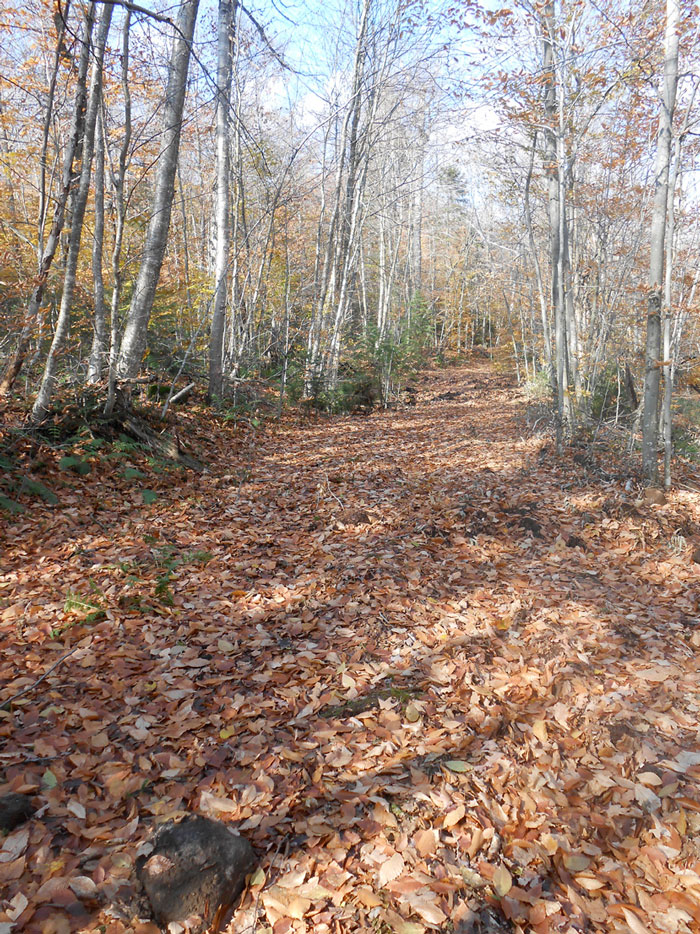
These road-like trails are unlike any other type of recreational trail in the Forest Preserve. Note the extensive bench cutting along the trail side and extensive grading. This picture is of the Seventh Lake Mountain Snowmobile Trail in the Moose River Plains Wild Forest.
Class II Community Connector Snowmobile Trail Construction Violates the Adirondack Park State Land Master Plan
The State Land Master Plan (SLMP) defines a snowmobile trail as “a marked trail of essentially the same character as a foot trail” and mandates that it be “compatible with the wild forest character of an area.” A snowmobile trail “should be designed and located in a manner than will not adversely affect adjoining private landowners or the wild forest atmosphere….” These road-like community connector “trails” simply do not have the character of a foot trail and violates both the wild forest character and the wild forest atmosphere of the area. PROTECT has consistently stated that community connector class II snowmobile trails do not conform to these three standards.
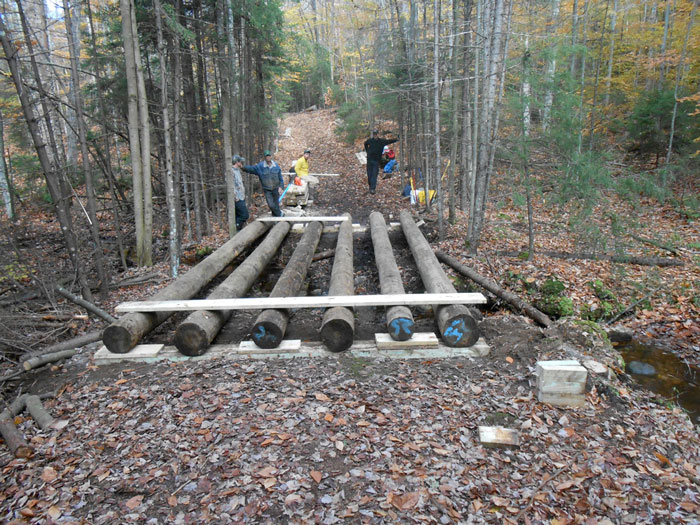
Oversized bridges to handle multi-ton trail groomers is a staple of these new class II community connector snowmobile trails.
There is no way this new community connector class II snowmobile “trail” bears any rational resemblance to something having the “character of a foot trail.” A community connector “trail” surface has been graded, leveled, and flattened by a multi-ton excavator. Extensive bench cuts are dug into side slopes that parallel the “trail” for long distances, protruding rocks are removed, extensive tree cutting is done, all understory vegetation is removed, and oversized bridges are built to support multi-ton groomers. In places bedrock may be fractured and chipped or gravel may be used to stabilize the trail surface. Bridges have been outfitted with plastic reflectors for nighttime driving.
A “foot trail” is where people walk single file. They step over roots and rocks. The trail surface is uneven and follows the terrain. There are scarcely any stumps of cut trees. Vegetation on the side often encroaches, and the trail is canopy covered. Steppingstones and split logs are commonly used to pass over streams and wet areas. There are no reflectors.
PROTECT has identified that there are many other areas of the SLMP for Wild Forest areas that are expressly violated by the design and construction of class II community connector class II snowmobile trails, the intended use, and by grooming with large tracked (motor vehicle) groomers. These include:
• Basic Guideline 2 (Motor Vehicles, Motorized Equipment and Aircraft 6) states that public access accommodations should be “consistent with the wild forest character.”
PROTECT does not believe that the new road-like class II community connector class II snowmobile trails are consistent with the wild forest character. The route’s width, bridges, reflectors, bench cuts, ledge cuts, use of gravel and straw, extensive surface alteration, tree removal, understory removal are all inconsistent with the “wild forest character” of Wild Forest areas.
• Basic Guideline 2 (Motor Vehicles, Motorized Equipment and Aircraft #8) states “All conforming structures and improvements will be designed and located so as to blend with the surrounding environment and require only minimal maintenance.” PROTECT does not believe that the new road-like class II community connector class II snowmobile trails meet the minimal maintenance test expressed here. DEC and the APA claim that the grooming of this trail is maintenance. PROTECT does not believe that numerous trips per week by a multi-ton tracked groomer on a major snowmobile route meets the “minimal maintenance” test.
• Basic Guideline 2 (Motor Vehicles, Motorized Equipment and Aircraft 9) states “All management and administrative actions and interior facilities in wild forest areas will be designed to emphasize the self-sufficiency of the user to assume a high degree of responsibility for environmentally sound use of such areas for his or her own health, safety and welfare.”
Leaving aside concerns of snowmobile “environmentally sound use” with their mileage rates less than most SUVs, PROTECT questions the “self-sufficiency” of the users of these new road-like class II community connector class II snowmobile trails where the principal recreational use of snowmobiling can only be accomplished if the trail has been regularly groomed by a multi-ton tracked groomer.
The expansion of motor vehicle use and creation of this widespread class II community snowmobile trail network will irreparably change the Forest Preserve.





